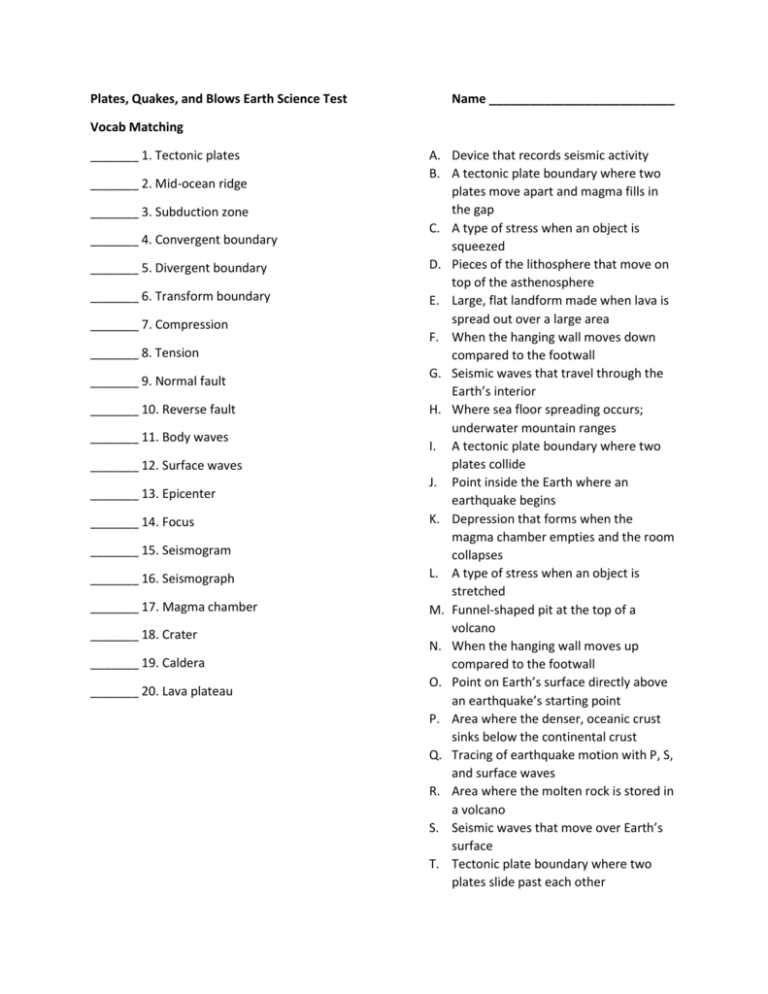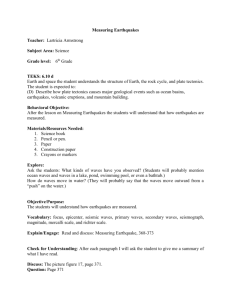earthquakes test
advertisement

Plates, Quakes, and Blows Earth Science Test Name ___________________________ Vocab Matching _______ 1. Tectonic plates _______ 2. Mid-ocean ridge _______ 3. Subduction zone _______ 4. Convergent boundary _______ 5. Divergent boundary _______ 6. Transform boundary _______ 7. Compression _______ 8. Tension _______ 9. Normal fault _______ 10. Reverse fault _______ 11. Body waves _______ 12. Surface waves _______ 13. Epicenter _______ 14. Focus _______ 15. Seismogram _______ 16. Seismograph _______ 17. Magma chamber _______ 18. Crater _______ 19. Caldera _______ 20. Lava plateau A. Device that records seismic activity B. A tectonic plate boundary where two plates move apart and magma fills in the gap C. A type of stress when an object is squeezed D. Pieces of the lithosphere that move on top of the asthenosphere E. Large, flat landform made when lava is spread out over a large area F. When the hanging wall moves down compared to the footwall G. Seismic waves that travel through the Earth’s interior H. Where sea floor spreading occurs; underwater mountain ranges I. A tectonic plate boundary where two plates collide J. Point inside the Earth where an earthquake begins K. Depression that forms when the magma chamber empties and the room collapses L. A type of stress when an object is stretched M. Funnel-shaped pit at the top of a volcano N. When the hanging wall moves up compared to the footwall O. Point on Earth’s surface directly above an earthquake’s starting point P. Area where the denser, oceanic crust sinks below the continental crust Q. Tracing of earthquake motion with P, S, and surface waves R. Area where the molten rock is stored in a volcano S. Seismic waves that move over Earth’s surface T. Tectonic plate boundary where two plates slide past each other _______ 21. Magma is formed a. From diamonds under high pressure b. Under high pressure and temperatures c. In Earth’s metal core d. From mid-ocean ridges _______ 22. What seismic waves cause the most damage? a. S waves b. P waves c. Surface waves d. Body waves _______ 23. All continents were together at one point in a large landmass called a. Pangaea b. Laurasia c. Gondwana d. Eurasia _______ 24. The theory that continents once formed a large landmass, drifted apart, and continue to move is called a. Sea-floor spreading b. Plate tectonics c. Wegener’s theory d. Continental drift _______ 25. S waves travel a. Faster than P waves b. Slower than P waves c. Slower than body waves _______ 26. All of the following are ways to predict a volcanic eruption EXCEPT a. Measuring the slope of a mountain b. Measuring earthquake frequency and intensity c. Measuring the temperature of the volcano d. Measuring the weather severity _______ 27. Because it’s on three tectonic plate boundaries, Japan has a high a. Earthquake hazard b. Elevation c. Tectonic letdown d. Intensity _______ 28. Which of the following would you expect from a shield volcano? a. Hot debris, ash, and gas shooting into the air b. Molten rock blowing into the air c. Violent explosions d. Calm lava flows _______ 29. The deep interior of the Earth can be mapped using a. Sonar b. Information from drilling expeditions c. Ocean waves d. Seismic waves _______ 30. New oceanic crust forms from a. Normal polarity b. Reverse polarity c. Sea-floor spreading d. Continental drift _______ 31. Seismic waves travel through Earth at different speeds depending on the a. Density b. Mass c. Area d. Shape _______ 32. What kind of deformation leads to earthquakes? a. Plastic deformation b. Elastic deformation c. Convergent deformation d. Shear deformation _______ 33. Strike-slip faults are created by a. Convergent motion b. Divergent motion c. Transcontinental motion d. Transform motion _______ 34. Where do volcanoes form and earthquakes happen? a. Mountainous areas b. Near the center of continents c. Along bodies of water d. Along plate boundaries _______ 35. Rock begins to melt when a. Both pressure and temperature decrease b. Both pressure and temperature increase c. Temperature increases and pressure decreases d. Temperature decreases and pressure increases 36. Describe one way tectonic plates can move (NOT a boundary). (2 points) 37. Why are composite volcanoes also called stratovolcanoes? (4 points) 38. What does the S-P time scale tell us? (3 points) 39. How can volcanoes form in the middle of a plate, like Hawaii? (2 points) 40. How is the epicenter of an earthquake related to its focus? (4 points) 41. As seismic waves travel further, what happens to the S-P time interval? (2 points) 42. List the layers of the Earth, from the outside to the inside. (5 points) 43. How are magma and lava related? (2 points) 44. How many seismographs are needed to find the epicenter of an earthquake? Why? (4 points)









